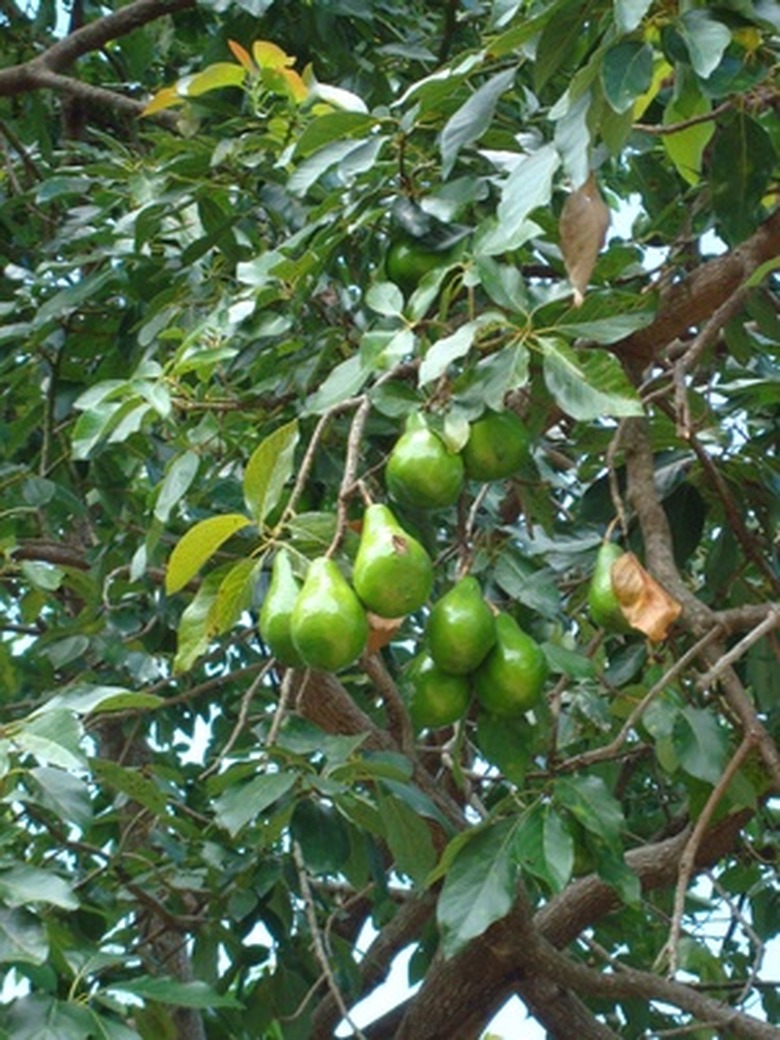Hardy Avocado Trees In Austin
Traditional cultivation of avocado trees (Persea Americana) takes place in the lower Rio Grande Valley in the southern tip of Texas around Corpus Christi and Brownsville. Austin is much farther north, and typically gardeners there deal with thin alkaline soil–much more challenging for successful cultivation of the subtropical avocado. Avocado can be grown in containers but inevitably becomes a tree taller than 30 feet. Austin is in U.S. Department of Agriculture hardiness zone 8b, although a warm winter may temporarily make it zone 9–cautiously good for avocado culture.
Geography
Austin, Texas, sits in the Texas Hill Country, where the elevation ranges from 400 to 1,400 feet above surrounding interior parts of southern Texas. This higher elevation gives Austin chilly winters, rarely with snow, but often down to 20 degrees F. "Sunset Western Garden Book" says occasional encounters with southward-moving Arctic air in winter every five to 10 years can drive city temperatures to as low as 0. Sufficient rainfall occurs in Austin to sustain avocado trees, more than 30 inches a year.
- Traditional cultivation of avocado trees (Persea Americana) takes place in the lower Rio Grande Valley in the southern tip of Texas around Corpus Christi and Brownsville.
- Austin is much farther north, and typically gardeners there deal with thin alkaline soil–much more challenging for successful cultivation of the subtropical avocado.
Avocado Types
Avocados tolerate only brief exposures to temperatures below 32. Of the three types of avocado, the Mexican strain is best suited to survive Austin winters, but even it will sustain significant damage and die-back when temperatures drop below 27, according to Julian Sauls of Texas A&M University. Avoid the less cold-resistant avocado varieties known as Guatemalan or West Indian. Mexican avocado tree leaves smell of anise when crushed.
Siting
Since winter hardiness remains a key limiting factor to successful culture of avocado trees in Austin, gardeners must provide as warm of a micro-climate as possible. Choose a site sheltered from prevailing cold winter winds. Sauls recommends the southern or southeastern side of a large building. Plant the tree no closer than 8 feet from the building since it will grow large. Avoid areas where the soil drains poorly or low areas where cold and frost tend to appear earliest in fall and late in spring.
- Avocados tolerate only brief exposures to temperatures below 32.
- Since winter hardiness remains a key limiting factor to successful culture of avocado trees in Austin, gardeners must provide as warm of a micro-climate as possible.
Cold Protection
Austin's climate inevitably will expose your outdoor avocado tree to temperatures well below freezing. As long as the trunk or roots never freeze, the avocado will rejuvenate in spring. Mounding soil around and over the trunk and roots in winter helps insulate these parts. Small trees benefit from placing a large tent-like covering of a blanket, frost cloth or thick plastic, according to Sauls. In extreme cases, a heat source like incandescent light bulbs or a wrapping of miniature Christmas lights can provide enough warmth under the tent covering to prevent tissue damage.
Expert Insight
Sauls suggests the Mexican variety "Lula" may prove the best avocado for cold hardiness in southern Texas. Any winter frost damage is left until spring when no threat of frost remains and new growth emerges; prune dead branches away in mid spring, not earlier. Lula bears its fruits in late September or October, and since the fruits do not ripen on the tree, pick them before a frost is expected, as late as January. Allow the fruits to ripen on the kitchen counter out of direct sunlight. Once the fruit is soft to the touch, in three to eight days, it's ready for eating.
- Austin's climate inevitably will expose your outdoor avocado tree to temperatures well below freezing.
- As long as the trunk or roots never freeze, the avocado will rejuvenate in spring.
References
- Texas A&M University: Home Fruit Production–Avocado
- Purdue University: Avocado–Persea Americana
- "Sunset Western Garden Book"; Kathleen Norris Brenzel, ed.; 2007
